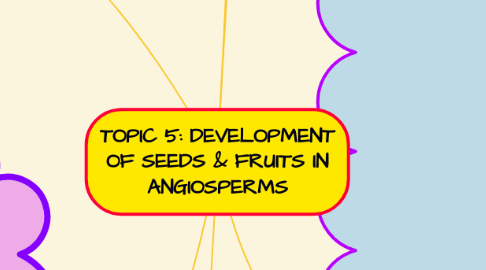
1. Pollen grain contain 2 cells
1.1. Tube cell
1.1.1. Form pollen tube
1.2. Generative cell
1.2.1. Form sperm nuclei
2. DEVELOPMENT OF SEED
2.1. Type
2.1.1. Monocotyledons
2.1.1.1. One cotyledon (scutellum)
2.1.2. Dicotyledons
2.1.2.1. Two cotyledons
2.2. Seed Germination
2.2.1. Mobilization of food reserves
2.2.2. Cell division and elongation
2.3. Seed Structure
2.3.1. Seed coat
2.3.1.1. Seed coat
2.3.1.1.1. Monocot
2.3.1.1.2. Dicot
2.3.1.2. Micropyle
2.3.1.2.1. Near the funiculus
2.3.2. Embryo axis
2.3.2.1. Plumule
2.3.2.1.1. First true leaves
2.3.2.1.2. Shoot Apical Meristem
2.3.2.1.3. Epicotyle
2.3.2.2. Hypocotyle
2.3.2.2.1. Become stem
2.3.2.3. Radical
2.3.2.3.1. Become root
2.3.3. Cotyledon
2.3.3.1. Absorb the nutrient from endosperm
2.4. Seed Development
2.4.1. 1) Pollen grains travel from the stamen to flowers
2.4.2. 2) Pollen grains land on the pistil germinate to form pollen tubes
2.4.3. 3) Pollen tubes travel to the ovary
2.4.4. 4) 1 pollen nuclei fuses egg cell to form a zygote
2.4.4.1. Zygote divided to form embryo assisted by hormones (cytokinin and auxin)
2.4.5. 5) Another 1 pollen nuclei fuses two polar nuclei to form triploid cell (endosperm)
2.4.5.1. 5) Another 1 pollen nuclei fuses two polar nuclei to form triploid cell (endosperm)
2.4.6. Both embryo and endosperm enclosed with seed coat
3. TYPE OF FRUIT DEVELOPMENT
3.1. True fruits
3.1.1. Fruit derived from ovary after fertilization
3.1.1.1. Example: Mango. Maize, Grape
3.2. False fruits/Pseudo-fruits
3.2.1. Fruit derived from the floral parts other than ovary
3.2.1.1. Peduncle - in cashew-nut
3.2.1.2. Thalamus - in apple, pear, gourd, cucumber
3.2.1.3. Fused perianth - in mulberyy
3.2.1.4. Calyx - in Dillenia
3.3. Partenocarpic fruits
3.3.1. Seedless fruits that are formed without fertilization
3.3.1.1. Example: Pineapple, banana, grape, orange
4. DEVELOPMENT OF FRUIT
4.1. Flower To Fruit
4.1.1. Flower will pollinated and fertilized
4.1.2. Then, petal of flower will wither
4.1.3. Ovary begin to swell
4.1.4. Petal will drop off and ovule develops into seed with embryo
4.1.5. The ovary grows bigger until it become a fruit
4.1.6. Seed develop inside the fruit and fruit grows bigger
4.2. Example :Tomato
4.2.1. Flower development
4.2.2. Open flower
4.2.3. Pollinated by bumble bee
4.2.4. Fruit set
4.2.5. Cell Divission & Growth
4.2.6. Afresh tomato
4.3. Method to produce fruit.
4.3.1. No pollination & No Fertilization
4.3.1.1. Bananas and Oranges
4.3.2. Pollination & No Fertilization
4.3.2.1. Papaya
5. PARTHENOCARPY
5.1. Causes
5.1.1. 1. Lack of pollination
5.1.2. 2. Pollination occurs, but no fertilization
5.1.3. 3. Fertilization is followed by embryo (seed) abortion
5.2. Can occur in 3 types:
5.2.1. Vegetative parthenocarpy
5.2.1.1. Fruits develop even without pollination
5.2.1.1.1. no seeds formed.
5.2.2. Stimulative parthenocarpy
5.2.2.1. Pollination occurs, but fertilization does not.
5.2.2.1.1. Stimulated by blowing air/growth hormones
5.2.3. stenospermacarpy
5.2.3.1. Fertilization is followed by embryo (seed) abortion.
5.2.3.2. pollination triggers fruit development, without mature seeds.
5.2.3.3. Stenospermocarpic fruits
5.2.3.3.1. Example: Most commercial seedless grapes. spayed with gibberellin
5.2.3.4. Hormone auxins, gibberellins and cytokinins
5.2.3.4.1. Sprayed on flower to stimulate the growth
5.3. Artificial Parthenocarpy
5.3.1. Hormone gibberellin is effective in producing seedless grapes and is the active component in preparations used to prevent premature dropping of fruit.
5.3.2. Hormone auxin treatment of young, unpollinated ovaries in certain cultivars of strawberry, tomato, grape, and orange.
5.4. Benefits:
5.4.1. 1) Provides seedless fruits and improves quality
5.4.2. 2) reduced the complete cost of the cultivation.
5.4.3. 3) Improved crop yield without using organic pesticides.
5.4.4. 4) Plant growth are natural and the fruits produced are larger
5.4.5. 5) keeps the insects and pests away without using chemicals
5.4.6. 6) Protects the plants from being attacked by pesticides
5.5. PARTHENOGENESIS
5.5.1. A component of apomixis
5.5.1.1. without fertilization
5.5.2. 1) Diploid parthenogenesis
5.5.2.1. produced seed with diploid embryo
5.5.2.2. causes by megaspore mother cell (2n)
5.5.2.3. Example: Strawberry, embryo develops from nucellus cell (2n) and produce more seed.
5.5.3. 2) Haploid parthenogenesis
5.5.3.1. produced seed with haploid embryo
5.6. APOMIXIS
5.6.1. Asexual formation of seeds from the maternal tissues of the ovule from the mother plant
5.6.1.1. plant gaining the ability to bypass the most fundamental aspects of sexual reproduction: meiosis and fertilization
5.6.2. Embryos develops from tissue other than zygote.
5.6.2.1. integument or nucellus cell undergo mitosis
5.6.2.1.1. produced embryo
5.6.3. situation known as polyembryony
5.6.3.1. Seeds generated from somatic cells
5.7. Stimulate with pollen
5.7.1. In certain plants, pollen are present incompatible with female flower
5.7.2. Pollen tube enters into an embryo sac through microphyle, but male gamete are not fertilize the egg cell
5.7.3. Pollen tube disappear, but it can stimulate the fruit.
6. MORPHOLOGY OF A TYPICAL FRUIT
6.1. Simple Fruit
6.1.1. Develop from single carpel or fused carpels of a single ovary
6.1.1.1. Exmples: Nuts and Beans
6.1.2. 2 types : Dry Fruits and Succulent Fruits
6.2. Aggregate Fruit
6.2.1. Develop from more than one carpel
6.2.1.1. Examples: Pineapples
6.2.2. All are in the same flower
6.3. Multiple/Composite Fruit
6.3.1. Develop from a cluster of flowers called an inflorescence
6.3.1.1. Examples: Jackfruit, Fig
6.4. Accesory Fruit
6.4.1. Develop from a ripened ovary but also have tissue derived from part of the plant outside the ovary
6.4.1.1. Examples: Strawberry, Apples, Pears
